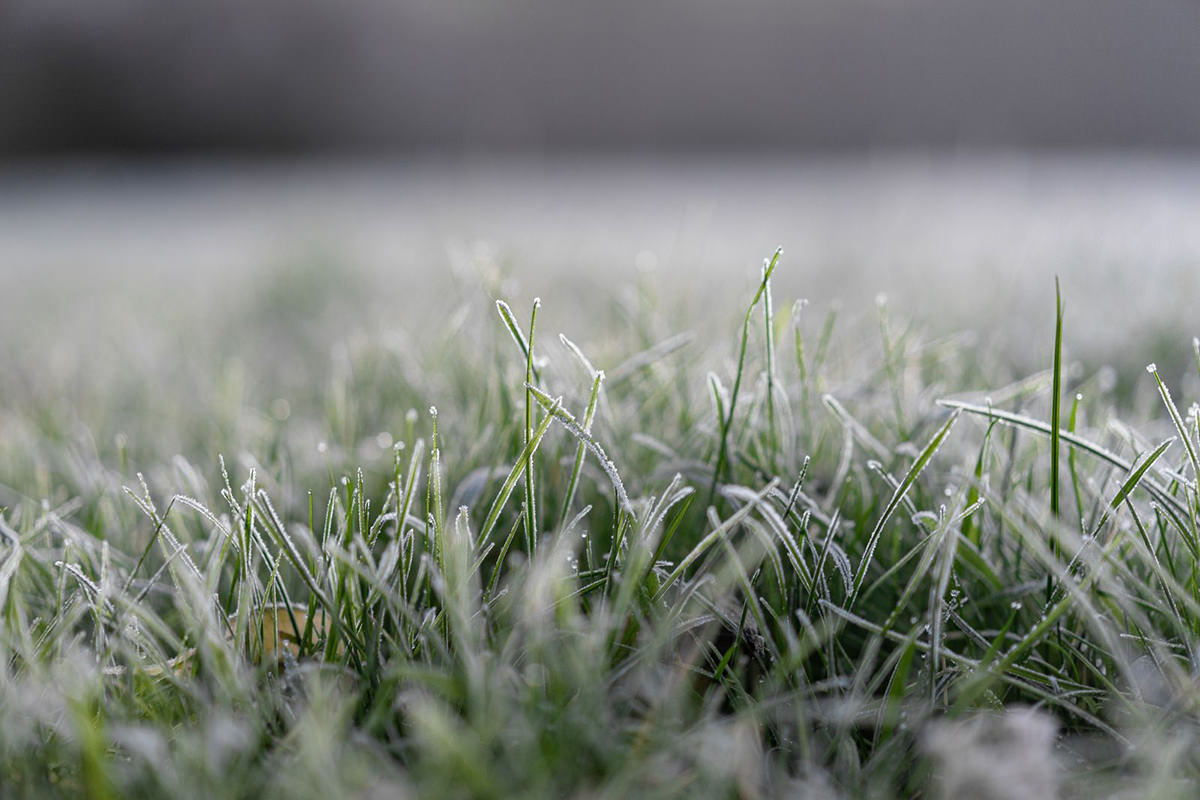Home>Gardening & Outdoor>Landscaping Ideas>How To Protect New Grass From Freeze


Landscaping Ideas
How To Protect New Grass From Freeze
Modified: August 17, 2024
Learn effective landscaping ideas to protect new grass from freeze and keep your lawn healthy. Implement these tips to safeguard your grass from cold weather.
(Many of the links in this article redirect to a specific reviewed product. Your purchase of these products through affiliate links helps to generate commission for Storables.com, at no extra cost. Learn more)
Introduction
Welcome to the exciting world of landscaping, where the beauty of nature meets the creativity of human design. As a landscaping enthusiast, you understand the importance of nurturing and protecting your outdoor space, especially when it comes to new grass. The arrival of freezing temperatures can pose a significant threat to the health and vitality of your freshly planted grass, making it crucial to take proactive measures to safeguard its well-being.
In this comprehensive guide, we will delve into the art of protecting new grass from freeze, equipping you with the knowledge and strategies needed to ensure the resilience and longevity of your lawn. From understanding the impact of freezing temperatures to implementing practical protective measures, this article will serve as your go-to resource for cultivating a lush and thriving landscape.
So, grab your gardening gloves and let's embark on a journey to safeguard your new grass from the chilling grasp of frost. With a blend of expertise and care, you can fortify your lawn against the winter cold and set the stage for a vibrant and resilient outdoor oasis.
Key Takeaways:
- Protecting new grass from freezing temperatures is crucial for its health and vitality. Gradual transition, hydration, and strategic watering are essential for preparing and safeguarding your lawn.
- Implementing protective measures such as covering, mulching, and utilizing windbreaks can fortify new grass against freezing temperatures, ensuring its resilience and longevity.
Read more: How To Protect Outdoor Plants From Freeze
Understanding the Threat of Freezing Temperatures
As the seasons transition and the mercury begins to plummet, the threat of freezing temperatures looms over your landscape, posing a potential hazard to the delicate nature of new grass. When exposed to frost and freezing conditions, young grass blades are susceptible to damage, hindering their growth and overall health. It’s essential to comprehend the impact of freezing temperatures on your lawn to effectively mitigate the associated risks.
Freezing temperatures can inflict harm on new grass through a process known as ice crystal formation. As the water within the plant cells freezes, it expands, leading to cellular damage and, in severe cases, the rupture of cell walls. This can result in wilting, browning, and ultimately, the demise of the grass. Additionally, prolonged exposure to freezing temperatures can impede the metabolic processes within the grass, stunting its development and vitality.
Furthermore, the freeze-thaw cycle, characterized by alternating periods of freezing and thawing, can exacerbate the stress on new grass. The expansion and contraction of the soil during these fluctuations can disrupt the delicate root systems, impeding the grass’s ability to absorb essential nutrients and moisture. As a result, the grass may struggle to establish strong roots and sustain its resilience in the face of environmental challenges.
By comprehending the detrimental effects of freezing temperatures on new grass, you can proactively prepare your landscape to mitigate these risks and foster a thriving, resilient lawn. With this understanding in mind, let’s explore the proactive measures you can take to shield your new grass from the chilling impact of frost.
Preparing Your Lawn for the Cold
As the chilly embrace of winter approaches, it’s crucial to ready your lawn for the impending cold spell. By taking proactive steps to prepare your landscape, you can fortify your new grass and bolster its defenses against freezing temperatures. Here are essential measures to consider as you gear up for the seasonal transition:
- Gradual Transition: Prior to the onset of freezing temperatures, facilitate a gradual transition for your new grass by reducing fertilization and adjusting your mowing practices. This approach encourages the grass to acclimate to the changing conditions, fostering resilience and adaptability.
- Hydration: Adequate hydration is paramount in fortifying new grass against the cold. Ensure that your lawn receives ample moisture before the arrival of freezing temperatures, as well-hydrated grass is better equipped to withstand the stress of frost.
- Soil Aeration: Enhance the oxygenation of the soil by aerating your lawn. This process promotes optimal root development and improves the soil’s capacity to retain essential nutrients and moisture, laying a robust foundation for your new grass.
- Minimize Traffic: Minimize foot traffic and heavy equipment usage on your lawn, especially as the temperatures drop. Limiting disturbances to the grass minimizes stress and helps maintain its resilience in the face of impending cold.
By proactively preparing your lawn for the cold, you can empower your new grass to confront freezing temperatures with fortitude and vigor. These preparatory measures lay the groundwork for implementing protective strategies that safeguard your grass from the potentially detrimental impacts of frost and freezing conditions.
Covering new grass with a frost cloth or blanket can help protect it from freezing temperatures. Make sure to secure the cover to prevent it from blowing away.
Implementing Protective Measures
As freezing temperatures encroach upon your landscape, it’s time to implement protective measures that shield your new grass from the chilling effects of frost. By leveraging strategic interventions, you can bolster the resilience of your lawn and minimize the risk of cold-induced damage. Here are key protective measures to consider:
- Covering: When a frost advisory is issued, consider covering your new grass with breathable, lightweight fabric or frost blankets. These covers provide insulation and protection, mitigating the impact of freezing temperatures on the tender grass blades.
- Strategic Watering: Prior to an anticipated frost, administer strategic watering to your lawn. This technique, known as “irrigation buffering,” involves saturating the soil to release latent heat, thereby raising the temperature of the grass and mitigating the effects of frost.
- Utilize Mulch: Apply a layer of organic mulch, such as straw or shredded leaves, to provide insulation and moisture retention for your new grass. Mulch acts as a protective barrier, shielding the grass from extreme temperature fluctuations and minimizing the risk of frost damage.
- Windbreaks: Erect temporary windbreaks, such as burlap screens or wooden barriers, to shield your lawn from cold, desiccating winds. These barriers help maintain a microclimate around the grass, reducing the impact of chilling winds on its delicate structure.
By implementing these protective measures, you can fortify your new grass against the adverse effects of freezing temperatures, fostering its resilience and fortitude in the face of winter’s icy grip. These interventions serve as a proactive defense, safeguarding your lawn and nurturing its capacity to thrive despite the challenges posed by frost and cold weather.
Additional Tips for Protecting New Grass
When it comes to safeguarding your new grass from the perils of freezing temperatures, a holistic approach that encompasses various protective strategies is key to ensuring its well-being. In addition to the fundamental measures discussed, here are additional tips to fortify your new grass and preserve its vitality during cold spells:
- Timing of Planting: When establishing new grass, consider the timing of planting to minimize exposure to freezing temperatures during the initial growth stages. Opt for planting in early fall or spring to facilitate robust establishment before the onset of winter.
- Choose Cold-Resilient Varieties: Select grass varieties that exhibit resilience to cold temperatures, such as fescue or ryegrass, to enhance the ability of your lawn to withstand frost and freezing conditions.
- Professional Consultation: Engage with a landscaping professional or horticulturist to gain insights tailored to your specific region and climate. Their expertise can provide valuable guidance on protective measures and grass care practices optimized for your local conditions.
- Monitor Weather Forecasts: Stay vigilant by monitoring weather forecasts and frost advisories. This proactive approach enables timely implementation of protective measures, minimizing the risk of cold-induced damage to your new grass.
- Optimize Nutrient Levels: Prioritize soil health by ensuring optimal nutrient levels to fortify the resilience of your new grass. Balanced fertilization and soil amendments contribute to the grass’s ability to withstand environmental stressors, including freezing temperatures.
By integrating these additional tips into your approach to protecting new grass, you can cultivate a robust and enduring lawn that thrives in the face of winter’s challenges. Embracing a comprehensive and proactive stance toward safeguarding your new grass sets the stage for a resilient and vibrant landscape, resilient against the potential hazards of freezing temperatures.
Conclusion
Congratulations on embarking on a journey to safeguard your new grass from the chilling embrace of freezing temperatures. By gaining a comprehensive understanding of the threats posed by frost and implementing proactive protective measures, you have fortified your lawn against the perils of winter’s icy grip. As you nurture your landscape, remember that the resilience and vitality of your new grass are a testament to your dedication and care.
As you navigate the seasonal transitions and prepare your lawn for the cold, your proactive approach sets the stage for a lush and resilient outdoor oasis. Embracing gradual transitions, strategic watering, and protective interventions such as covering and mulching, you have equipped your new grass to confront freezing temperatures with fortitude and vigor.
Remember, the journey to protecting your new grass is an ongoing endeavor, requiring attentiveness and adaptability as the seasons unfold. By integrating the additional tips and embracing a holistic approach to lawn care, you are nurturing a landscape that thrives despite the challenges posed by frost and cold weather.
So, as the winter winds whisper and the frost descends, take pride in knowing that your new grass is fortified and prepared to weather the cold. Your commitment to its well-being ensures that it will emerge resilient and vibrant, ready to flourish as the seasons transition once again.
With your newfound knowledge and proactive measures, your landscape is poised to thrive, a testament to the harmonious blend of nature’s beauty and your dedicated stewardship. As you continue to nurture your outdoor haven, may your new grass stand as a testament to the resilience and vitality that blossoms under your care.
Frequently Asked Questions about How To Protect New Grass From Freeze
Was this page helpful?
At Storables.com, we guarantee accurate and reliable information. Our content, validated by Expert Board Contributors, is crafted following stringent Editorial Policies. We're committed to providing you with well-researched, expert-backed insights for all your informational needs.















0 thoughts on “How To Protect New Grass From Freeze”